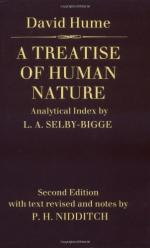This dye, formed as above, contains three circumstances worthy of our attention. First, Certain causes, such as gravity, solidity, a cubical figure, &c. which determine it to fall, to preserve its form in its fall, and to turn up one of its sides. Secondly, A certain number of sides, which are supposed indifferent. Thirdly, A certain figure inscribed on each side. These three particulars form the whole nature of the dye, so far as relates to our present purpose; and consequently are the only circumstances regarded by the mind in its forming a judgment concerning the result of such a throw. Let us, therefore, consider gradually and carefully what must be the influence of these circumstances on the thought and imagination.
First, We have already observed, that the mind is determined by custom to pass from any cause to its effect, and that upon the appearance of the one, it is almost impossible for it not to form an idea of the other. Their constant conjunction in past instances has produced such a habit in the mind, that it always conjoins them in its thought, and infers the existence of the one from that of its usual attendant. When it considers the dye as no longer supported by the box, it can not without violence regard it as suspended in the air; but naturally places it on the table, and views it as turning up one of its sides. This is the effect of the intermingled causes, which are requisite to our forming any calculation concerning chances.
Secondly, It is supposed, that though the dye be necessarily determined to fall, and turn up one of its sides, yet there is nothing to fix the particular side, but that this is determined entirely by chance. The very nature and essence of chance is a negation of causes, and the leaving the mind in a perfect indifference among those events, which are supposed contingent. When therefore the thought is determined by the causes to consider the dye as falling and turning up one of its sides, the chances present all these sides as equal, and make us consider every one of them, one after another, as alike probable and possible. The imagination passes from the cause, viz. the throwing of the dye, to the effect, viz. the turning up one of the six sides; and feels a kind of impossibility both of stopping short in the way, and of forming any other idea. But as all these six sides are incompatible, and the dye cannot turn up above one at once, this principle directs us not to consider all of them at once as lying uppermost; which we look upon as impossible: Neither does it direct us with its entire force to any particular side; for in that case this side would be considered as certain and inevitable; but it directs us to the whole six sides after such a manner as to divide its force equally among them. We conclude in general, that some one of them must result from the throw: We run all of them over in our minds: The determination of the thought is common to all; but no more of its force falls to the share of any one, than what is suitable to its proportion with the rest. It is after this manner the original impulse, and consequently the vivacity of thought, arising from the causes, is divided and split in pieces by the intermingled chances.




